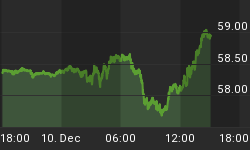Market Vectors Gold Miners ETF (GDX) seeks to replicate as closely as possible, the price and yield performance of the NYSE Gold Miners. The Index provides exposure to publicly traded companies worldwide involved primarily in the mining for gold, representing a diversified blend of small, mid and large-capitalization stocks. The Index includes selected companies with market capitalizations greater than $100 million that have a daily average traded volume of at least 50,000 shares over the past six months. The Fund's portfolio includes a range of small, mid-sized, and large gold mining companies from around the globe.
Yesterday the Gold Miners ETF (GDX) fought the good fight but came up short for the 8th day in a row. There is a strong level of support at $52.00 but what has confounded investors is the level of resistance at $55.00. With the Gold ETF (GLD) down .8% to close at $144.93 and the Silver ETF (SLV) down 0.5% to close at $33.00. GDX once again acted as scripted. While GDX closed at $53.74, it did have an intraday high of $54.24 but in the end the stock could not come close to breaking through the important resistance level of $55.00.
A look at the chart will show that Friday July 1st, it closed trading at $2.13 below the 50 day moving average, $3.88 below the 200 day moving average and a staggering $4.06 under the 150 day moving average.

Mining for gold has always been romanticized as an adventurous way to get rich quick. As a business, however, it's very difficult to make a profit. Gold production is incredibly energy and labor intensive. Over the past few years, rising crude oil prices and increasing demand for higher wages have forced global gold production costs to increase quite dramatically. Rising production costs have narrowed profit margins for gold mining companies. And recently, many large investors have exited their gold equities (in the green) over fears in continued increases in gold production costs. According to data from VM Group/Haliburton Mineral Services, since 2007, the cash cost to produce gold has increased a whopping 57.4%.
I believe the key factor in rising cash costs has been the weakness of the U.S. dollar (in which gold is priced), due to the vast amounts of excess liquidity generated by QE1 and QE2. Inflationary pressure from the recent flood of various government stimulus packages has sent worldwide wages and energy prices skyward.
After Greece moved a step closer to securing international aid, the dollar lost a quarter of a percent against a basket of currencies, as the euro rallied. The short term decline in the dollar would have traditionally elevated gold prices since it reduces the marginal cost of buying it for non-U.S. investors; however, today the market does what it always does - it confounded me as an inverse correlation came into play.
This leads me to conclude that until we see a renewed program of quantitative easing the gold and silver stocks will continue to flounder.
For the meantime the market has shrugged off the end of QE2 and put in an amazing show of strength to close up 168 points on the DOW, a 5.4% gain for the week and its best performance on a percentage basis since July 2009.
In the next few weeks we will see if it's for real or not.
















